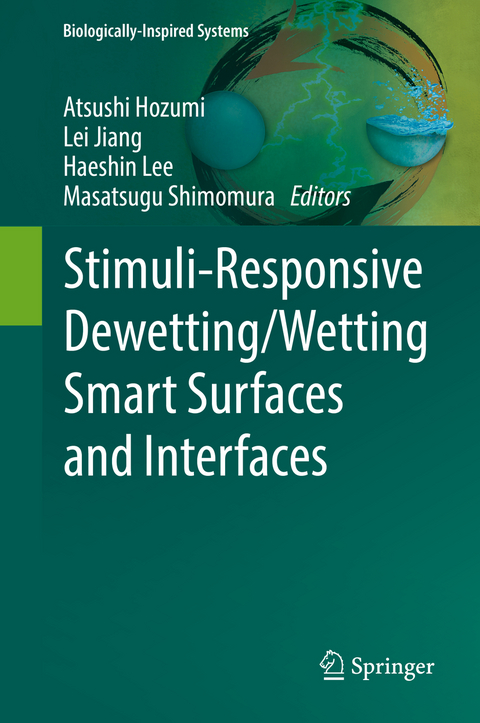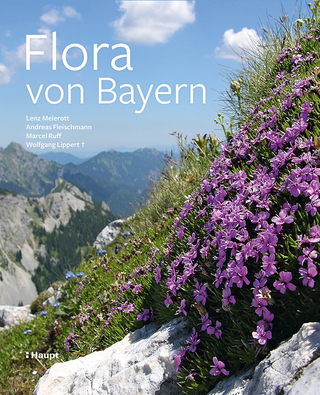
Stimuli-Responsive Dewetting/Wetting Smart Surfaces and Interfaces
Springer International Publishing (Verlag)
9783319926537 (ISBN)
Atsushi Hozumi is a group leader of Advanced Surface and Interface Chemistry Group, Structural Materials Research Institute, The National Institute of Advanced Industrial Science and Technology (AIST), Nagoya, Japan. He received a PhD in Material Processing Engineering at Nagoya University, Japan, in 1997. He then joined National Industrial Research Institute of Nagoya (NIRIN), Ministry of Trade and Industry, Japan in 1999 (reorganized as AIST in 2001). He also spent 2007 as a visiting scholar at University of Bristol, England (Prof. Stephen Mann’s group) and as a visiting professor of University of Massachusetts Amherst, USA (Prof. Thomas J. McCarthy’s group). His research interests are wettability/dewettability, biomimetic materials, micro/nanofabrication and self-assembled monolayers, and their practical applications. He currently serves on the editorial boards of the Materials Letters, Elsevier. Professor Haeshin Lee studied at KAIST where he received his B.S. degree in Biological Sciences between in 1996. He received his Ph.D. degree at Biomedical Engineering Department, Northwestern University in 2007. He started his professional carrier from 2009 at Department of Chemistry, KAIST. He is a currently director of Center for Nature-inspired Technology (CNiT) at KAIST. Haeshin Lee invented the first material-independent surface chemistry named ‘polydopamine’ in 2007, and this study has been one of the most cited paper in surface chemistry. He is the founding member of Korea Academy of Science Young Scholars and is an Associate Editor in Biomaterials Science (RSC).After graduating from Kyushu University in 1980, Masatsugu Shimomura engaged in the field of biomimetic chemistry as an assistant professor of Prof. Toyoki Kunitake’s laboratory. He developed the research of polymeric Langmuir-Blodgett films at Tokyo University of Agriculture and Technology as an associate professor from 1985, and moved to Hokkaido University at 1993 for starting a new laboratory of the bottom-up nanotechnology based on self-organization and biomimetics. Self-organized honeycomb-patterned polymer films are newly developed by collaboration with many industrial companies and the RIKEN institute where he held concurrently post of the principle investigator from 1999 to 2007. After moving to Tohoku University at 2007 he organized a national research project on Engineering Neo-Biomimetics, and started an educational program on biomimetics at Chitose Institute of Science and Technology from 2014. He worked with Prof. Helmut Ringsdorf of Mainz University in 1982 and Prof. Erich Sackmann of TU-Munich in 1987, respectively. He is a Professor emeritus of Hokkaido University and Tohoku University.
Chapter1. Introduction of Stimuli-Responsive Wetting/Dewetting Smart Surfaces and Interfaces.- Part 1. Stimuli-Responsive Dewetting/Wetting Surfaces/Interfaces. Chapter 2. Photo-Responsive Superwetting Surface.- Chapter 3. pH Responsive Reversibly Tunable Wetting Surfaces.- Chapter 4. Thermal-Responsive Superwetting Surface.- Chapter 5. Electric-Responsive Superwetting Surface.- Chapter6. Liquids on Shape-Tunable Wrinkles.- Chapter7. Solvent Response.- chapter8. Magnetic-Responsive Superwetting Surface.- Part 2. Practical Applications. chapter 9. Stimuli-Responsive Smart Surfaces for Oil/Water Separation Applications.- Chapter 10. Anti-(bio)Fouling.- Chapter 11. Toward Eadaptive Anti-icing Coating.- Chapter 12. Stimulus-Responsive Soft Surface/Interface Toward Applications in Adhesion, Sensor and Biomaterial.- Chapter 13. Liquid manipulation.- Chapter14. Material-Independent Surface Modification Inspired by Principle of Mussel Adhesion.- Chapter 15. Stimuli-Responsive Mussel-inspired Polydopamine Material.
| Erscheinungsdatum | 08.12.2018 |
|---|---|
| Reihe/Serie | Biologically-Inspired Systems |
| Zusatzinfo | XI, 464 p. 299 illus., 192 illus. in color. |
| Verlagsort | Cham |
| Sprache | englisch |
| Maße | 155 x 235 mm |
| Gewicht | 916 g |
| Themenwelt | Naturwissenschaften ► Biologie ► Botanik |
| Naturwissenschaften ► Chemie ► Organische Chemie | |
| Technik ► Maschinenbau | |
| Schlagworte | smart surface/interface • smart surfaces and interfaces • stimuli response • Superhydrophobicity • superominipohobicity |
| ISBN-13 | 9783319926537 / 9783319926537 |
| Zustand | Neuware |
| Informationen gemäß Produktsicherheitsverordnung (GPSR) | |
| Haben Sie eine Frage zum Produkt? |
aus dem Bereich


